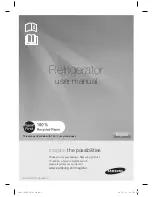
Safety information
_5
• The water supply to this refrigerator must only
be installed/connected by a suitably qualifi ed
person and connected to a potable water
supply only.
• In order to operate the ice-maker properly, water
pressure of 138~862 kPa (1.4~8.8 kgf/cm
2
) is
required.
• Do not spray volatile material such as insecticide
onto the surface of the appliance.
-
As well as being harmful to humans, it may also
result in an electric shock, fi re or problems with
the product.
CAUTION SIGNS FOR
CLEANING AND MAINTENANCE
• Do not directly spray water inside or
outside the refrigerator.
- There is a risk of fi re or electric shock.
• Do not use or place any substances sensitive
to temperature such as infl ammable sprays,
infl ammable objects, dry ice, medicine, or
chemicals near the refrigerator. Do not keep
volatile or infl ammable objects or substances
(benzene, thinner, propane gas, etc.) in the
refrigerator.
- This refrigerator is for storing food only.
- This may result in a fi re or an explosion.
• Do not spray cleaning products directly on the
display.
-
Printed letters on the display may come off.
• Remove any foreign matter or dust from the
power plug pins. But do not use a wet or damp
cloth when cleaning the plug, remove any foreign
material or dust from the power plug pins.
- Otherwise there is a risk of fi re or electric shock.
• Never put fi ngers or other objects into the
dispenser hole and ice chute.
-
It may cause a personal injury or material
damage.
• Unplug the refrigerator before cleaning and
performing maintenance.
SEVERE WARNING SIGNS
FOR DISPOSAL
• Ensure that none of the pipes on the back
of the appliance are damaged prior to
disposal.
• R-600a or R-134a is used as a refrigerant.
Check the compressor label on the rear of
the appliance or the rating label inside the
refrigerator to see which refrigerant is used for
your refrigerator. When this product contains
fl ammable gas (Refrigerant R-600a), contact
your local authority in regard to safe disposal
of this product. Cyclopentane is used as an
insulation blowing gas. The gases in insulation
material require special disposal procedure.
Please contact your local authorities in regard to
the environmentally safe disposal of this product.
Ensure that none of the pipes on the back of the
appliances are damaged prior to disposal.
The pipes shall be broken in the open space.
• When disposing of this product or other
refrigerators, remove the door/door seals, door
latch so that small children or animals cannot
become trapped inside. Leave the shelves in
place so that children may not easily climb
inside. Children should be supervised to ensure
that they do not play with the old appliance.
• Please dispose of the packaging material for this
product in an environmentally friendly manner.
ADDITIONAL TIPS FOR PROPER USAGE
• In the event of a power failure, call the local
offi ce of your Electricity Company and ask how
long it is going to last.
-
Most power failures that are corrected within
an hour or two will not affect your refrigerator
temperatures. However, you should minimize the
number of door openings while the power is off.
-
Should the power failure last more than 24
hours, remove all frozen food.
• If keys are provided with the refrigerator, the
keys should be kept out of the reach of children
and not be in the vicinity of the appliance.
• The appliance might not operate consistently
(possibility of temperature becoming too warm
in the refrigerator) when sited for an extended
period of time below the cold end of the range
of temperature for which the refrigerating
appliance is designed.
• Do not store food which spoils easily at low
temperature, such as bananas, melons.
• Your appliance is frost free, which means there
is no need to manually defrost your appliance,
as this will be carried out automatically.
• Temperature rise during defrosting can comply
with ISO requirements. But if you want to
prevent an undue rise in the temperature of
the frozen food while defrosting the appliance,
please wrap the frozen food up in several layers
of newspaper.
• Any increase in temperature of frozen food
during defrosting can shorten its storage life.
CAUTION
CAUTION
DA99-03403A(0.5).indd Sec2:5
DA99-03403A(0.5).indd Sec2:5
2012.5.25 1:27:23 PM
2012.5.25 1:27:23 PM






































